Japan
Wood Products Prices
Dollar Exchange Rates of 25th
July 2018
Japan Yen 110.97
Reports From Japan
¡¡
Japan/EU trade deal to
eliminate tariffs
Japan and the European Union have signed a significant
free trade deal that will lead to deep cuts or eliminate
tariffs on nearly all goods.
An on-line statement from the EU says ¡°The Economic
Partnership Agreement between the EU and Japan is the
biggest ever negotiated by the European Union. It creates
an open trade zone covering over 600 million people and
nearly a third of global GDP.
It will remove the vast majority of the €1 billion of duties
paid annually by EU companies exporting to Japan, and
has led to the removal of a number of long-standing
regulatory barriers, for example on cars.
It will also open up the Japanese market of 127 million
consumers to key EU agricultural exports and will
increase EU export opportunities in a range of sectors. The
Agreement follows the highest standards of labour,
environmental and consumer protection and has a
dedicated chapter on sustainable development. It is the
first trade agreement negotiated by the European Union to
include a specific commitment to the Paris climate
agreement.¡±
See:
https://ec.europa.eu/commission/news/president-juncker-25th-eujapan-
summit-2018-jul-17_en
Consumers signal reluctance to buy durable goods
Japan's Cabinet Office has released details of its July
consumer confidence survey which pointed to an
unexpectedly decline in July. The overall livelihood index
fell as did other indices. Of concern to the timber sector
was the sharp drop in consumer willingness to buy durable
goods.

Hints of policy change at Bank of Japan
Towards the end of July the yen firmed against the dollar,
giving up some of the weakness following the US interest
rate increase but then fell back which analysts put down to
the traditional ¡®rush to yen¡¯ when a crisis looms, the latest
being the destabilised global economy.
Despite a flurry of negative economic indicators some
suspect the BoJ is considering policy changes to make its
currency management ¡®more sustainable¡¯ but the
interpretation of sustainable is open to question. In the
second half of July the yen moved to 112 to the dollar but
has firmed to 110-111 yen per dollar by month end.

Disaster relief hampered by scorching
temperatures
There are still almost 5,000 evacuees from the recent
floods and landslides staying in shelters. Recently the
Tokyo Metropolitan Government has said it offers free
housing for victims. The capital has available 200
residences in council housing areas. Relief and recovery
efforts in the disaster hot areas have been hampered by
extremely hot weather with day time temperatures rising
to over 35 degrees centigrade for almost two weeks.
Housing starts dip year on year
Despite being up on levels in May, year on year Japan's
housing starts fell sharply in June according to statistics
from the Ministry of Land, Infrastructure, Transport and
Tourism. June 2018 starts were down over 7% reversing
the tear on year rise seen in May. Ministry data also
pointed to a decline in orders received by the major
construction companies.
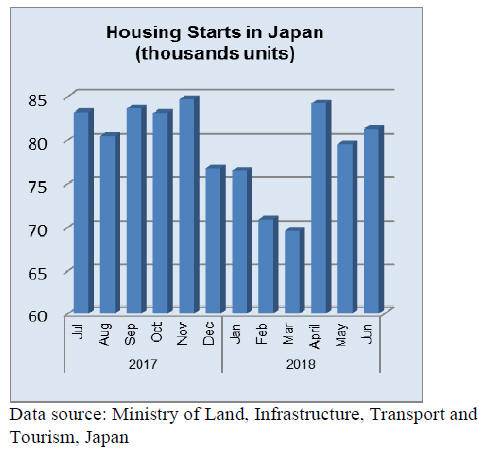
Import round up
Doors
May door imports
As if to compensate for the decline in door imports in
March and April, the value of May imports skyrocketed
30% month on month with the top three suppliers, China,
the Philippines and Indonesia all posting gains.
Shipments from China regularly account for around 60
%
of all imports and in May shippers in China saw a 30%
increase in delivers to Japan. The top three suppliers of
wooden doors to Japan accounted for over 90% of May
2018 imports.
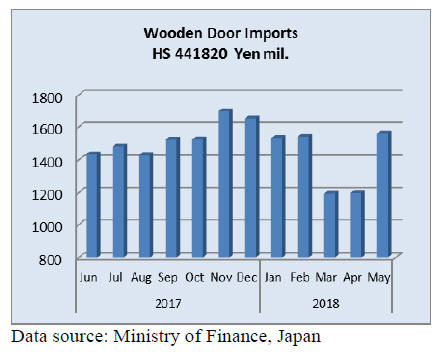
Window imports
May window imports
Year on year Japan¡¯s May imports of wooden windows
were down 20% and month on month they were little
changed from a month earlier.
The top three shippers, as was the case in April, were
China (43%), USA (26%) and the Philippines (24%). In
May, shippers in China saw a 20% increase in total
shipments and shippers in the Philippines posted a 5% rise
in the value of shipments.

Assembled flooring
May imports
As in previous months wooden flooring imports were
dominated by HS 441875 followed by HS441879.
Together these two categories of assembled flooring
accounted for over 90% of the value of all assembled
wooden flooring imports in May.
In order of rank by value, China, Malaysia and Indonesia
were the main shippers of HS441875 in May while for
HS441879 the main shippers were Indonesia and
Thailand.
The value of May 2018 imports of wooden flooring was
the highest for the past 12 months and almost up to the
record level seen in January 2016. Year on year, May
2018 imports of wooden flooring were up 60% and there
was a 50% increase from levels in April.
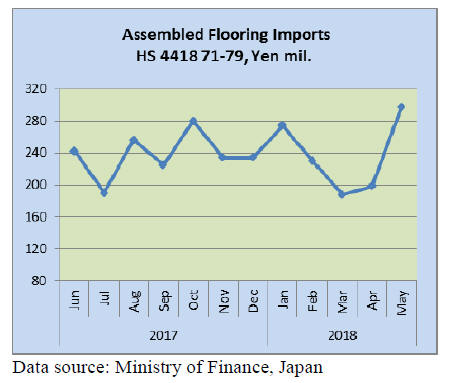
Plywood
May plywood imports
As in previuos months plywood in HS 441231 accounted
for most of Japan¡¯s imports of plywood. As in April, May
imports of HS441231 accounted for over 89% of all
plywood imports. HS441234 accounted for just 5% of
May plywood imports.
Year on year May plywood imports from all sources rose
5% with shipments being dominated by Malaysia and
Indonesia with smaller volumes from China and now,
Vietnam. May shipments from Malaysia and Indonesia
were up slightly (2% and 3% respectively) while
shipments from China jumped 14%.
 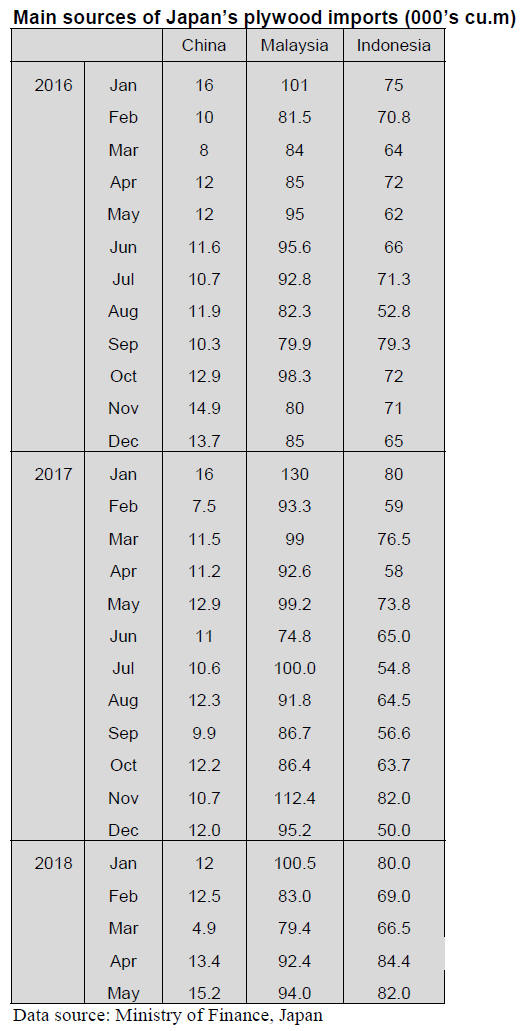
Trade news from the Japan Lumber Reports (JLR).
For the JLR report please see:
http://www.nmokuzai.
com/modules/general/index.php?id=7
Indonesian floor base plywood supply
Delayed shipment and escalating prices of Indonesian
floor base plywood have continued for more than a year.
Reason is tight log supply. Even after rainy season was
over, log supply has not recovered and tight supply may
continue until arrival of next rainy season in both Malaysia
and Indonesia.
Log production in both countries plunged sharply by
heavier rain fall. This results in inflating log prices. Floor
base plywood prices finally exceeded $750 level and June
offer prices are $780 per cbm C&F for 11.5 mm thick
overlay better panel. Previous settled prices were $730-
740 so this is steep climb. Plywood suppliers in Indonesia
realize the prices are too high but they have to pass high
log cost onto export prices.
Meantime, Japanese floor manufacturers need to accept
higher prices to continue manufacturing floor products so
they purchased future supply in May and June. With
exchange rate of over 100 yen per dollar, $780 would cost
about 1,950 yen per sheet, the highest ever. Japanese floor
manufacturers carry some inventories and some orders
made about six months to a year ago have not arrived yet.
These are lower cost so the manufacturers can average
down the high cost of recent orders then they have been
using more domestic softwood and plantation wood like
falcate plywood, which are another items to average down
the cost.
In short, imported floor base plywood is no longer reliable
material for Japanese floor manufacturers with delayed
shipments and skyrocketing prices.
Plywood
Movement of both imported and domestic plywood is
getting slower. Domestic softwood plywood market is
weakening in wholesale channels. Slower demand by
precutting plants is getting active again.
Imported plywood market lost upward momentum. The
prices had been climbing as export prices have
kept soaring then in April, the movement started
stagnating so that the price escalation stopped.
May softwood plywood production was 251,700 cbms out
of which structural panel was 234,400 cbms, 0.8% less
than May last year and 2.0% less than April. With series of
holidays in early May, operating days are less than other
months but starts-up of new mill added some production
so total production did not drop much.
The manufacturers are determined to keep present sales
prices but actual market prices are bit confusing with some
low offers.
Market of imported plywood confused some after lower
cost inventories were in the market in June but the volume
is limited so that the market is tightening again in July.
New arrivals cost higher so sales price increase is
necessary by one notch.
Imported South Sea (tropical) plywood market
Export prices by the suppliers continue climbing so future
prices will be firm and higher but the market in Jap an is
not able to follow escalating cost with weak demand.
Particularly concrete forming for coating panel market is
soft.
The demand skidded after early May. The prices had been
climbing since last year but the movement slowed after
May so price hike stopped.
Actually the prices are down in June when the importers
and wholesalers need to reduce the inventories before
closing the book. Cargoes arrived in April are lower in
cost compared to recent contracted cargoes so some low
offers are proposed. This pushes market prices downward
in general.
Supply side continue bullish with tight supply of logs so
export plywood prices seem to keep escalating so the
importers face rising future cost and weakening market
inJapan so they look for low cost items in Japan market to
average down the cost but with limited inventories, it is
hard to find such low priced panels.
After all, gap between high cost offered by supply side
and weakening market prices in Japan by lack of demand
is widening and it becomes much harder to commit future
cargoes.
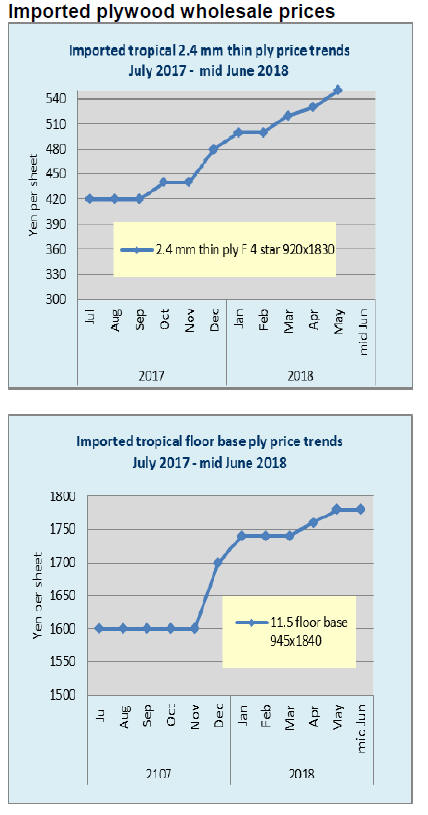 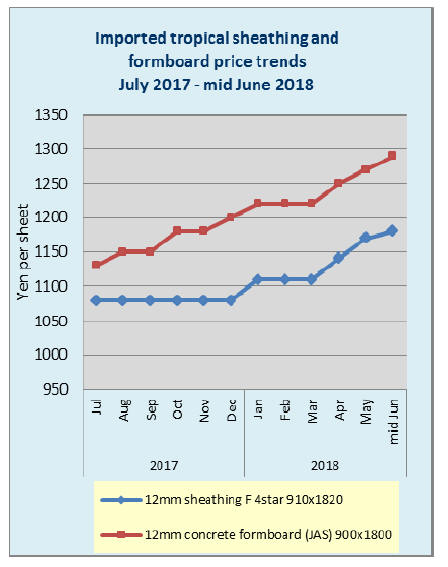
Weakening domestic softwood plywood market
Domestic softwood plywood demand had been very active
in 2016 and 2017 by high housing starts so that the
shipment had been more than the production by the
manufacturers, which have been operating with maximum
capacity but such robust demand finally eased in early
2018.
Demand slowness during winter months is normal every
year and in last two years, the demand picked up in early
spring so that the manufacturers continued full production
even in winter months.
For the first time in three years, the demand and prices are
softening due to slowdown of orders from precutting
plants as start of rental units are declining.
Accumulated starts of wooden units for the first four
months are 3,156 units less than the same period of last
year. This may be the reason that orders from precutting
plants decrease. Since middle of March, the market prices
have started weakening and there were some spotty low
offers. Even after new fiscal year started in April, the
demand continues dormant.
Building materials trading firms have started selling
without any commission since they need to dispose of
certain amount of allocated volume by the manufacturers.
Start-up of new Miye softwood plywood plant by Nisshin
in April gives psychological impact to the market as an
additional supply source.
If this bearish mood is temporary or not depends on orders
by precutting plants. Large precutting plants are having
ample orders for the summer and the manufacturers have
such bullish view that the demand should recover shortly
so that they continue full production for coming fall
demand.
The manufacturers had to curtail the production by oversupply
in 2014 and 2015.
This is the first time that the prices softened in distributing
channels. Present prices of 12 mm 3x6 are 1,030-1,050
yen per sheet delivered, 10-20 yen lower than May. The
manufacturers think that this is temporary dip and the
demand should come back shortly.
High export log prices in Kyushu
In Kyushu, where is major supply region of export logs,
prices of export logs stay up high. Prices of 4 meter cedar
C grade logs are 8,500 yen per cbm delivered. Prices of
logs for lumber have been weak due to seasonal reason
and prices of logs for biomass power generation are lower
than export.
Kyushu is geographically close to Korea and China market
so prefecture of Kagoshima, Miyazaki and Kumamoto are
major log suppling regions.
In Southern Kyushu, cedar logs with top diameter of 50
cm and large cypress logs are practically all for export and
log exporters compete with each other to secure the
volume.
Weak yen is favorable factor for export so the momentum
of log export seems to continue for some time. Market of
competing logs for biomass power generation is weakly
holding at about 6,500-7,000 yen per ton delivered chip
plants because of over-supply and power plants are
reducing purchase of logs for wood chip.
Meantime, market of logs for lumber (A class logs) is also
weak because sawmills are reluctant to buy too much logs
in the rain season for fear of beetle damages.
In Southern Kyushu, price difference between A class logs
for sawmills and C clsss logs for export is narrowing to
2,000-2,500 yen per cbm since C class log prices hold up
and bottom is supporting upper class log prices.
However, demand for A class logs should recover toward
fall and substituting demand of domestic logs from high
priced import wood products should increase in the second
half of the year.
May softwood plywood production was 251,700 cbms out
of which structural panel was 234,400 cbms, 0.8% less
than May last year and 2.0% less than April. With series of
holidays in early May, operating days are less than other
months but starts-up of new mill added some production
so total production did not drop much.
The manufacturers are determined to keep present sales
prices but actual market prices are bit confusing with
some low offers.
Market of imported plywood confused some after lower
cost inventories were in the market in June but the volume
is limited so that the market is tightening again in July.
New arrivals cost higher so sales price increase is
necessary by one notch.
Weakening domestic softwood plywood market
Domestic softwood plywood demand had been very active
in 2016 and 2017 by high housing starts so that the
shipment had been more than the production by the
manufacturers, which have been operating with maximum
capacity but such robust demand finally eased in early
2018.
Demand slowness during winter months is normal every
year and in last two years, the demand picked up in early
spring so that the manufacturers continued full production
even in winter months.
For the first time in three years, the demand and prices are
softening due to slowdown of orders from precutting
plants as start of rental units are declining.
Accumulated starts of wooden units for the first four
months are 3,156 units less than the same period of last
year. This may be the reason that orders from precutting
plants decrease. Since middle of March, the market prices
have started weakening and there were some spotty low
offers. Even after new fiscal year started in April, the
demand continue dormant.
Building materials trading firms have started selling
without any commission since they need to dispose of
certain amount of allocated volume by the manufacturers.
Start-up of new Miye softwood plywood plant by Nisshin
in April gives psychological impact to the market as an
additional supply source.
If this bearish mood is temporary or not depends on orders
by precutting plants. Large precutting plants are having
ample orders for the summer and the manufacturers have
such bullish view that the demand should recover shortly
so that they continue full production for coming fall
demand.
The manufacturers had to curtail the production by oversupply
in 2014 and 2015. This is the first time that the
prices softened in distributing channels. Present prices of
12 mm 3x6 are 1,030-1,050 yen per sheet delivered, 10-20
yen lower than May.
The manufacturers think that this is temporary dip and the
demand should come back shortly.
High export log prices in Kyushu
In Kyushu, where is major supply region of export logs,
prices of export logs stay up high. Prices of 4 meter cedar
C grade logs are 8,500 yen per cbm delivered. Prices of
logs for lumber have been weak due to seasonal reason
and prices of logs for biomass power generation is lower
than export.
Kyushu is geographically close to Korea and China market
so prefecture of Kagoshima, Miyazaki and Kumamoto are
major log suppling regions.
In Southern Kyushu, cedar logs with top diameter of 50
cm and large cypress logs are practically all for export and
log exporters compete with each other to secure the
volume.
Weak yen is favorable factor for export so the momentum
of log export seems to continue for some time. Market of
competing logs for biomass power generation is weakly
holding at about 6,500-7,000 yen per ton delivered chip
plants because of over-supply and power plants are
reducing purchase of logs for wood chip.
Meantime, market of logs for lumber (A class logs) is also
weak because sawmills are reluctant to buy too much logs
inrainy season in fear of beetle damages.
In Southern Kyushu, price difference between A class logs
for sawmills and C clsss logs for export is narrowing to
2,000-2,500 yen per cbm since C class log prices hold up
and bottom is supporting upper class log prices.
However, demand for A class logs should recover toward
fall and substituting demand of domestic logs from high
priced import wood products should increase in the second
half of the year.
|